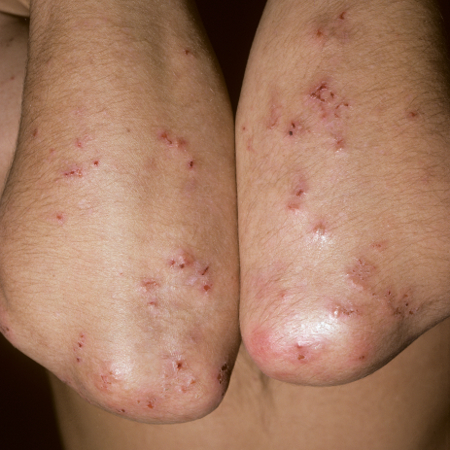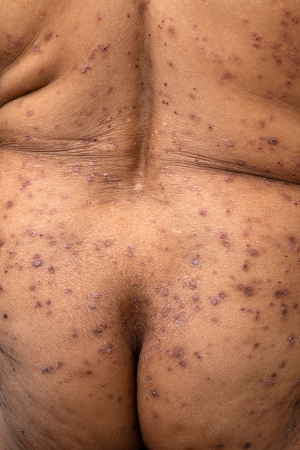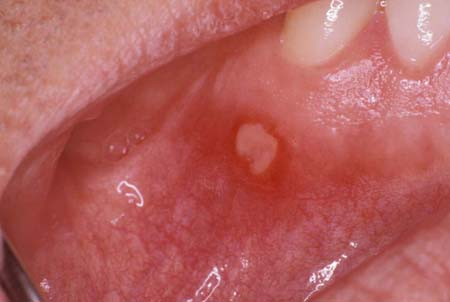History and exam
Key diagnostic factors
common
polymorphic rash
Presence of symmetric, grouped, polymorphic skin lesions including erythema, vesicles, blisters, crusts, urticarial plaques, papules, and excoriation, usually distributed on typical areas such as the extensor surfaces of upper and lower limbs (mainly elbows and knees), buttocks, shoulders, and scalp. Less commonly affected sites include the posterior nuchal area, and/or the hairline.[2][20] Skin lesions usually heal without scarring, but can leave post-inflammatory hyperpigmentation.
[Figure caption and citation for the preceding image starts]: Characteristic pruritic papulovesicular rash of dermatitis herpetiformis, affecting the elbowsCID - ISM/Science Photo Library; used with permission [Citation ends]. [Figure caption and citation for the preceding image starts]: Characteristic pruritic papulovesicular rash of dermatitis herpetiformis, affecting back and buttocksScience Photo Library; used with permission [Citation ends].
[Figure caption and citation for the preceding image starts]: Characteristic pruritic papulovesicular rash of dermatitis herpetiformis, affecting back and buttocksScience Photo Library; used with permission [Citation ends].
pruritus
Pruritus is a universal feature in all patients, which often deeply affects their quality of life.[2]
Other diagnostic factors
uncommon
burning sensations affecting the skin
atypical cutaneous manifestations
Occasionally, dermatitis herpetiformis may occur with atypical cutaneous presentations, including palmar or plantar petechiae, or other rarer signs such as hyperkeratotic lesions of palms and soles, leukocytoclastic vasculitis-like lesions, and prurigo-like lesions.[19]
oral lesions
The oral mucosa is a less commonly affected area, patients may present with aphthoid ulcers.[18]
[Figure caption and citation for the preceding image starts]: Aphthous ulcer: a less common manifestation of dermatitis herpetiformisFrom the collection of Dr Michaell A. Huber, UTHSCSA School of Dentistry; used with permission [Citation ends].
diarrhoea
Approximately 15% to 20% of patients with dermatitis herpetiformis show gastrointestinal symptoms typical of coeliac disease, such as diarrhoea, constipation, abdominal bloating or pain, and weight loss. However, the majority of patients have only mild gastrointestinal involvement or are asymptomatic.[2][11]
constipation
Approximately 15% to 20% of patients with dermatitis herpetiformis show gastrointestinal symptoms typical of coeliac disease, such as diarrhoea, constipation, abdominal bloating or pain, and weight loss.[2][11] However, most patients have only mild gastrointestinal involvement or are asymptomatic.[2]
abdominal bloating
Approximately 15% to 20% of patients with dermatitis herpetiformis show gastrointestinal symptoms resembling those of coeliac disease, such as diarrhoea, constipation, abdominal bloating or pain, and weight loss.[2][11] However, most of the patients have only mild gastrointestinal involvement or are asymptomatic.[2]
abdominal pain
Approximately 15% to 20% of patients with dermatitis herpetiformis show gastrointestinal symptoms resembling those of coeliac disease, such as diarrhoea, constipation, abdominal bloating or pain, and weight loss.[2][11] However, most of the patients have only mild gastrointestinal involvement or are asymptomatic.[2]
weight loss
Approximately 15% to 20% of patients with dermatitis herpetiformis show gastrointestinal symptoms resembling those of coeliac disease, such as diarrhoea, constipation, abdominal bloating or pain, and weight loss.[2][11] However, most of the patients have only mild gastrointestinal involvement or are asymptomatic.[2]
anaemia
Patients with gastrointestinal symptoms may have signs of anaemia (e.g., pallor, pale conjunctiva) due to malabsorption.[2]
peripheral oedema
Approximately 15% to 20% of patients with dermatitis herpetiformis show gastrointestinal symptoms resembling those of coeliac disease; these patients may also have signs of malabsorption, which may include peripheral oedema.[2]
Risk factors
strong
gluten ingestion
coeliac disease
The majority (up to 70%) of patients with dermatitis herpetiformis have a mild enteropathy with mild villous atrophy; the remainder may show severe intestinal involvement or, in few cases, the presence of normal bowel mucosa.[15]
genetic predisposition
A close correlation has been found between some human leukocyte antigen (HLA) types and dermatitis herpetiformis, such as HLA-DQ2 (present in around 95% of patients), and to a lesser extent, HLA-DQ8 (present in around 5% of patients).[10][11]
First-degree relatives of patients with gluten sensitive enteropathy or dermatitis herpetiformis are characteristically more likely to be affected by either disorder. A study of 73 twin pairs performed to estimate disease concordance rate by zygosity and HLA genotypes, discordance times, progression rates to disease, and heritability found that concordance was significantly higher in monozygotic (83.3% probandwise, 71.4% pairwise) than in dizygotic (16.7% probandwise, 9.1% pairwise) pairs.[12]
Use of this content is subject to our disclaimer